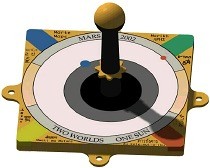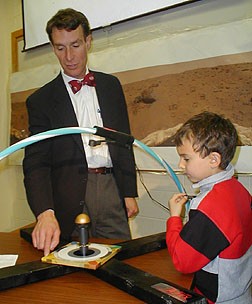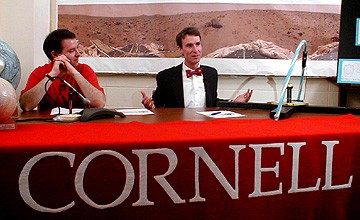Martian sundial designed for 2001 space mission is unveiled by Bill Nye "The Science Guy"
By David Brand
For the first time in history, humanity will send a sundial to another planet. Inscribed with the motto "Two Worlds, One Sun," the sundial will travel to Mars aboard NASA's Mars Surveyor 2001 lander.
Pictures of the sundial, taken by the lander's panoramic camera after its arrival at Mars in January 2002, will reveal the passage of the hours and seasons as the sun moves across the Martian sky. And the sundial's central black, gray, and white rings and corner color tiles will act as a calibration target — a kind of test pattern — to adjust the brightness and tint of pictures taken by the camera.
In the process, the sundial could become one of the most photographed objects ever sent to another world.
The sundial design team included Jon Lomberg, an artist and creative consultant to the Mauna Kea Center for Astronomy Education, Hawaii; Tyler Nordgren, an artist and astronomer at the U.S. Naval Observatory in Flagstaff, Ariz.; sundial expert Woodruff Sullivan, professor of astronomy at the University of Washington; Louis Friedman, executive director of the Planetary Society; Cornell University astronomers Steven Squyres and Jim Bell; and Bill Nye, the television writer and host of the public television children's science program, "Bill Nye The Science Guy."
"Our ancestors made astonishing discoveries about the nature of the heavens and our place in it by closely watching the motion of shadows," said Nye, unveiling the sundial design at a press conference at Cornell today (April 21). "Now, at the dawn of the next century, we can make observations of new shadows, this time on another planet."
Appropriately for a science instrument involving Nye, the sundial design evolved through suggestions and drawings from children across the United States, solicited by Sheri Klug, director of Arizona State University's Mars Education and Outreach Program.
The sundial will be 3 inches (about 8 centimeters ) square, and will weigh just over 2 ounces (60 grams). Made of aluminum to minimize its weight, the anodized metal surfaces will be black and gold. The photometric surfaces, which will be used to calibrate the Mars lander's color panoramic camera, called the Pancam, are made of a special silicone rubber compound. Photo-etching and engraving will be used to apply the lettering and the drawings to the face and side panels of the sundial.
The central black, gray and white calibration rings are arranged to represent the orbits of Mars and Earth, and red and blue dots show the positions of the planets at the time of the landing in 2002. Portions of the central shadow post are gold to represent the sun.
The sundial carries a message for future Martian explorers who may seek it out, or who may find it by good fortune. The four gold side panels around the sundial's base are engraved with the words:
"People launched this spacecraft from Earth in our year 2001. It arrived on Mars in 2002. We built its instruments to study the Martian environment and to look for signs of life. We used this post and these patterns to adjust our cameras and as a sundial to reckon the passage of time. The drawings and words represent the people of Earth. We sent this craft in peace to learn about Mars' past and about our future. To those who visit here, we wish a safe journey and the joy of discovery."
The Pancam is is one of four instruments being developed for the Mars 2001 lander under the leadership of Squyres, a Cornell professor of astronomy, assisted by 20 researchers around the world, including Bell, an assistant professor of astronomy, and a team of about 20 Cornell undergraduates and staff. Together these instruments form the Athena Precursor Experiment, or APEX, which will be a prelude to the Athena Mars rover and sample return mission in 2003.
To help design the sundial, Arizona State's Klug sought the ideas of schoolchildren. Announcements were made at a meeting of the National Science Teachers Association in Seattle in 1998, and via several international electronic mailing lists. Over 160 design concepts were submitted from children across the country.
One idea suggested by children was that the sundial bear writing in many languages, representing the diverse cultures of Earth. The face of the sundial is engraved with the word "Mars" in Arabic, Bengali, Braille, Chinese, Danish, English, French, German, Greek, Hawaiian, Hebrew, Hindi, Inuktituk, Italian, Japanese, Korean, Lingala, Malay-Indonesian, Portuguese, Russian, Spanish and Thai. Together these languages are used by more than three quarters of Earth's population. Also included are ancient Sumerian and Mayan. Mars figured prominently in both the Sumerian and Mayan cultures.
Several children also suggested that stick-figure drawings be included, representing the people of Earth. Artist Lomberg combined stick figures drawn by children with other space-related motifs to create the series of drawings that appear on the sundial's side panels. The aim of these pictures is to capture the optimistic spirit of the text message, combining a childlike sense of wonder with a vision of the human future in space.
Once the spacecraft lands on Mars and the exact orientation of the sundial can be determined, viewers will be able to tell local Martian time from sundial images and a computer-generated overlay posted on the World Wide Web. Mirrored segments along the outer ring of the sundial will also reveal the color of the sky above the lander. Over the course of a day, viewers on Earth will thus see the passage of time on Mars recorded in the sweep of the shadow of the sundial's central post and the changing colors of the Martian sky. The shadow will also reveal the changing Martian seasons over the full duration of the mission.
Media Contact
Get Cornell news delivered right to your inbox.
Subscribe

